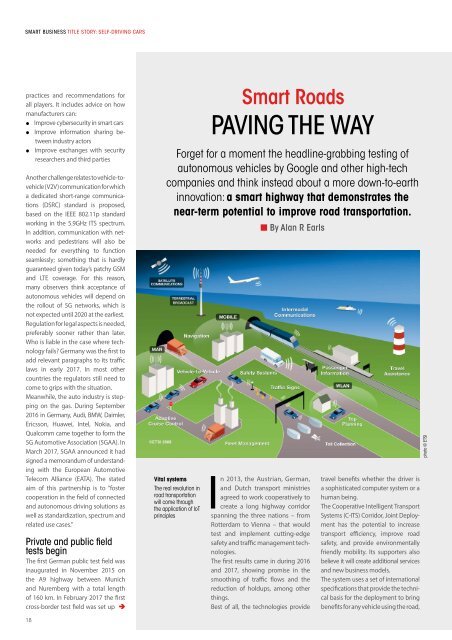Smart Industry 1/2018
Smart Industry 1/2018 - The IoT Business Magazine - powered by Avnet Silica
Smart Industry 1/2018 - The IoT Business Magazine - powered by Avnet Silica
You also want an ePaper? Increase the reach of your titles
YUMPU automatically turns print PDFs into web optimized ePapers that Google loves.
<strong>Smart</strong> Business Title Story: Self-driving cars<br />
practices and recommendations for<br />
all players. It includes advice on how<br />
manufacturers can:<br />
••<br />
Improve cybersecurity in smart cars<br />
••<br />
Improve information sharing between<br />
industry actors<br />
••<br />
Improve exchanges with security<br />
researchers and third parties<br />
Another challenge relates to vehicle-tovehicle<br />
(V2V) communication for which<br />
a dedicated short-range communications<br />
(DSRC) standard is proposed,<br />
based on the IEEE 802.11p standard<br />
working in the 5.9GHz ITS spectrum.<br />
In addition, communication with networks<br />
and pedestrians will also be<br />
needed for everything to function<br />
seamlessly; something that is hardly<br />
guaranteed given today’s patchy GSM<br />
and LTE coverage. For this reason,<br />
many observers think acceptance of<br />
autonomous vehicles will depend on<br />
the rollout of 5G networks, which is<br />
not expected until 2020 at the earliest.<br />
Regulation for legal aspects is needed,<br />
preferably sooner rather than later.<br />
Who is liable in the case where technology<br />
fails? Germany was the first to<br />
add relevant paragraphs to its traffic<br />
laws in early 2017. In most other<br />
countries the regulators still need to<br />
come to grips with the situation.<br />
Meanwhile, the auto industry is stepping<br />
on the gas. During September<br />
2016 in Germany, Audi, BMW, Daimler,<br />
Ericsson, Huawei, Intel, Nokia, and<br />
Qualcomm came together to form the<br />
5G Automotive Association (5GAA). In<br />
March 2017, 5GAA announced it had<br />
signed a memorandum of understanding<br />
with the European Automotive<br />
Telecom Alliance (EATA). The stated<br />
aim of this partnership is to “foster<br />
cooperation in the field of connected<br />
and autonomous driving solutions as<br />
well as standardization, spectrum and<br />
related use cases.”<br />
Private and public field<br />
tests begin<br />
The first German public test field was<br />
inaugurated in November 2015 on<br />
the A9 highway between Munich<br />
and Nuremberg with a total length<br />
of 160 km. In February 2017 the first<br />
cross-border test field was set up<br />
<strong>Smart</strong> Roads<br />
Paving the Way<br />
Forget for a moment the headline-grabbing testing of<br />
autonomous vehicles by Google and other high-tech<br />
companies and think instead about a more down-to-earth<br />
innovation: a smart highway that demonstrates the<br />
near-term potential to improve road transportation.<br />
Vital systems<br />
The real revolution in<br />
road transportation<br />
will come through<br />
the application of IoT<br />
principles<br />
■ By Alan R Earls<br />
In 2013, the Austrian, German,<br />
and Dutch transport ministries<br />
agreed to work cooperatively to<br />
create a long highway corridor<br />
spanning the three nations – from<br />
Rotterdam to Vienna – that would<br />
test and implement cutting-edge<br />
safety and traffic management technologies.<br />
The first results came in during 2016<br />
and 2017, showing promise in the<br />
smoothing of traffic flows and the<br />
reduction of holdups, among other<br />
things.<br />
Best of all, the technologies provide<br />
travel benefits whether the driver is<br />
a sophisticated computer system or a<br />
human being.<br />
The Cooperative Intelligent Transport<br />
Systems (C-ITS) Corridor, Joint Deployment<br />
has the potential to increase<br />
transport efficiency, improve road<br />
safety, and provide environmentally<br />
friendly mobility. Its supporters also<br />
believe it will create additional services<br />
and new business models.<br />
The system uses a set of international<br />
specifications that provide the technical<br />
basis for the deployment to bring<br />
benefits for any vehicle using the road,<br />
photo © ETSI<br />
18
















